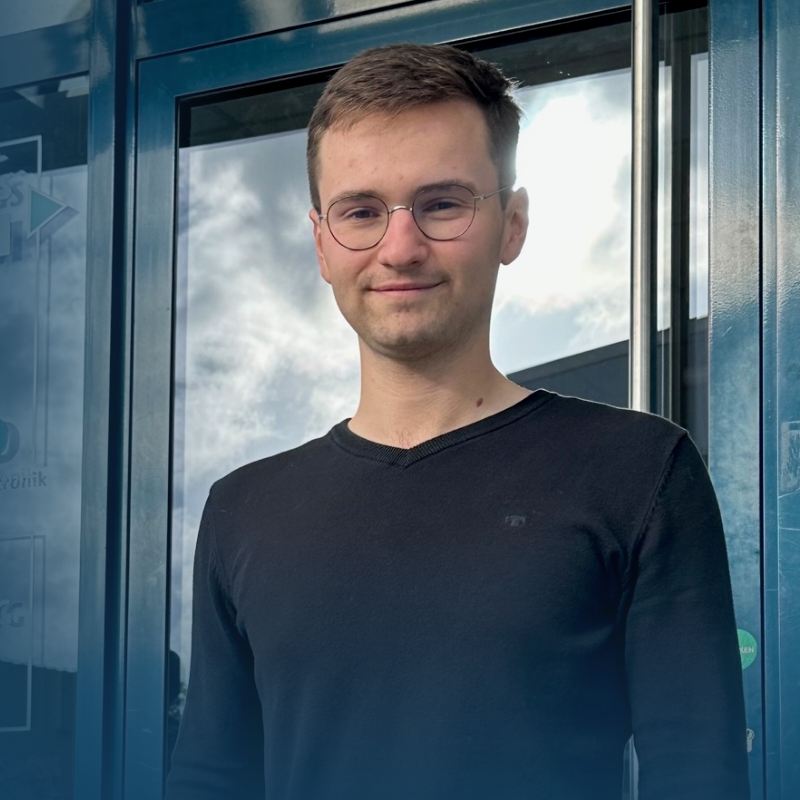Hello Felix,
We are thrilled to have you strengthen our team and to have had your active support as a working student for the past three years. Your enthusiasm for hardware and your fresh ideas have not only impressed us during your studies but have also led to a permanent role with us at Helbako. Congratulations on completing your master’s degree!
In the following, Felix describes in his own words how he experienced his master’s thesis at Helbako, the challenges he had to overcome, and the experiences he will take with him into his professional future.
Why is the master’s thesis on this topic relevant for Helbako GmbH?
In recent years, the number of driver assistance systems in vehicles has increased significantly and will continue to rise in the coming years. Since these systems take on safety-relevant functions, a redundant and secure power supply of the control units must be ensured. This is achieved through the use of a second battery, which is powered by a DCDC converter. Thus, an additional 12V electrical system is integrated into the vehicle, with the DCDC converter taking on the role of the power supply. It replaces the alternator for the second electrical system in the vehicle. This requires the converter to meet high standards of reliability and safety.
How was the process of the master’s thesis in the development department at Helbako GmbH?
In my case, I had already worked as a working student at Helbako before starting the thesis and approached my supervisor about a topic for a final thesis. After joint planning and drafting a suitable task, appropriate supervision at the university was sought. Once found, a joint agreement on the start date and submission deadline is made between the university and the company. Depending on the university and guidelines, the supervisor in the company can act as an examiner and grader. The supervisor in the company mainly takes on the role of technical support during the thesis. This person can always be approached for questions or assistance. Furthermore, Helbako GmbH covered all the costs for the required materials and compensated the work within the thesis as a working student job.
Now more details about the task: What were the requirements for the DCDC converter in the master’s thesis, and how were they implemented?
Due to the high safety requirements, the DCDC converter must fulfill several functions, such as safe short-circuit prevention between the two electrical systems. Additionally, a very high efficiency (>95%) at a power of 500W needs to be achieved. To meet these requirements, the DCDC converter is implemented with galvanic isolation. This means using a transformer for galvanically isolated power transmission. A planar transformer, provided by a company according to our specifications, and a self-wound transformer with a PQ core and litz wire are used. To achieve the high efficiency, a galvanically isolated topology with a full bridge on the primary side and a current doubler on the secondary side is used. The full bridge reduces losses in the power switches, thus increasing efficiency. The current doubler refers to the circuit topology on the secondary side of the DCDC converter. Instead of one output coil, two are used, dividing the output current. This reduces losses on the secondary side. The downside of the circuit design is the increased cost due to the high number of components. However, the transformer design can be simplified since the full bridge allows a simple winding on the primary side and the current doubler also allows a simple winding on the secondary side.
Furthermore, a relatively young technology of field-effect transistors as power switches is used. These are gallium nitride field-effect transistors (GaN-FETs), which are based on the same functional principle as classical FETs, but are not made of classic silicon and PN junctions, but with the semiconductor material GaN. This results in several advantages over traditional Si-MOSFETs. The GaN-FETs are much smaller in size, reducing the parasitic component sizes. This drastically reduces switching times and increases switching frequency. This has an effect on the entire circuit, as higher frequencies can reduce the inductances and capacitances in both the filter structures and the DCDC converter. Furthermore, the transformer can be reduced in size. This saves space, costs, and is more efficient.
What was the result of the thesis? What experiences were gained?
The result of the thesis was a fundamentally functioning circuit that can transfer 12V to 12V with galvanic isolation. Due to a suboptimal layout, which resulted in problems with the power switches, the targeted efficiency could not be achieved, unfortunately. The final efficiency peaked at 92%. The thesis addressed possible improvements and developed possible changes to the layout and circuit.
The thesis presented Helbako with a potential solution for realizing a 12V-12V DCDC converter, which the company can potentially use or improve in the future. The insights gained about GaN-FETs are also useful and can be applied and utilized in other projects.
In conclusion, I can say that the thesis has been beneficial for both parties, and I would recommend anyone to write their thesis at a company, especially at Helbako. I particularly noticed the helpfulness and support of all colleagues in development and across departments, who could always be approached and stood by one’s side. In hindsight, I would write a thesis in a company or at Helbako again anytime, as it is very practical, I was able to gather many experiences, and it also allowed me a smooth career start after the thesis at Helbako.
